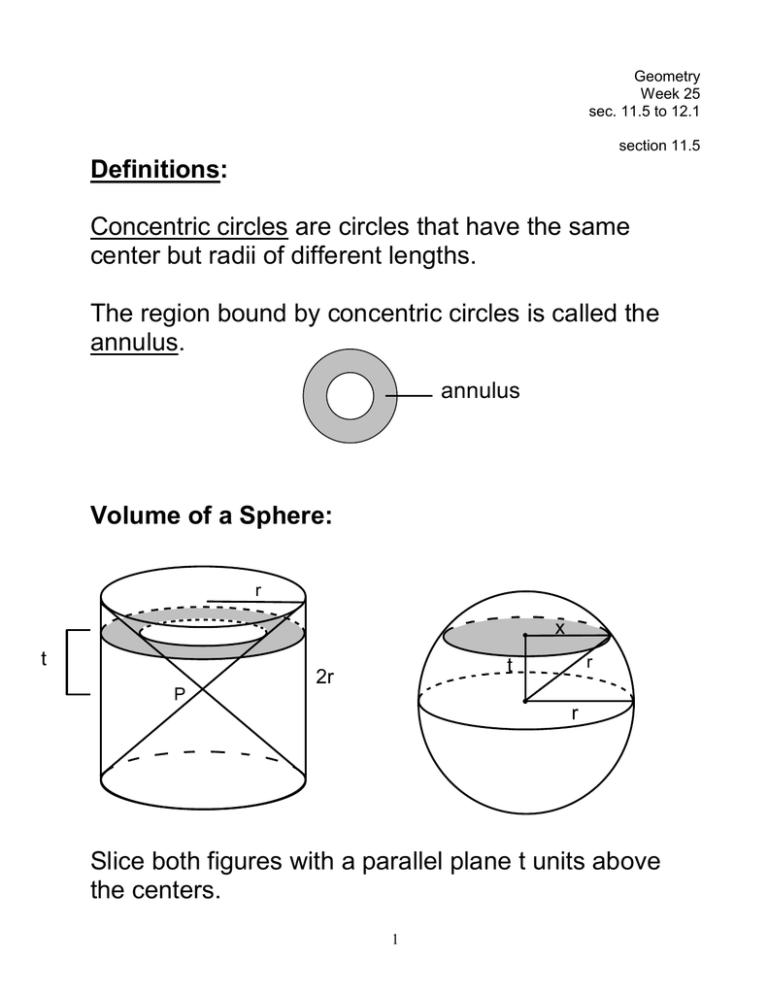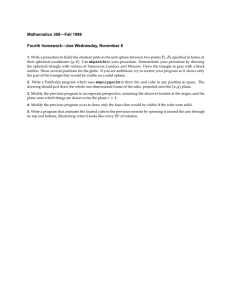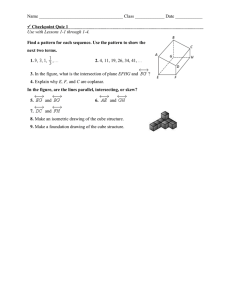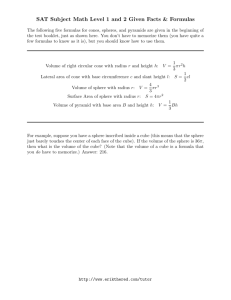annulus
advertisement

Geometry Week 25 sec. 11.5 to 12.1 section 11.5 Definitions: Concentric circles are circles that have the same center but radii of different lengths. The region bound by concentric circles is called the annulus. annulus Volume of a Sphere: r x t P r t 2r r Slice both figures with a parallel plane t units above the centers. 1 Note the right triangle formed in the sphere with sides t, r, and x. Using Pythagorean Theorem we get: x2 = r2 – t2 Cross sections of both figures: r t x Area = x2 Area = ( r2 – t2) (substitute x2 above) Area = r2 – t2 Area = Alg - Asm Area = r2- t2 Same!! ***By Cavaleri’s Principle, since every horizontal plane cuts the figures into regions with equal areas, the volume of the sphere equals the volume of the solid between the cones and the cylinder. 2 Vsphere = Vcylinder – V2cones V = r2 H – 2(⅓r2 H) V = r2(2r) – 2(⅓r2(r)) V = 2r3 – (2/3)r3 V = (4/3)r3 Theorem 11.7: The volume of a sphere is 4/3 times the cube of the radius: V = 4r3 3 Example: Find the volume of a sphere of radius 3. V = (4/3)(33) V = (4/3)(27) V = 36 cubic units Sample Problem: Find the volume of a sphere whose great circle has a circumference of 16. C = 2r 16 = 2r r=8 V = (4/3)(83) V = (4/3)(512) V = (2048/3) 3 Regular Polygon Volume √2 3 e V= 12 tetrahedron V = e3 cube (hexahedron) octahedron V= dodecahedron V= V= icosahedron 4 √2 e3 3 ( 15 + 7√5 ( 3 )e 15 + 5√5 12 ) 3 e3 Section 11.6 Construction 16: Segment division Given: AB Construct: Five congruent segments with lengths that total AB. 1. Draw a ray from A, forming an acute angle. 2. Place the point of the compass at A and, without changing the compass measure, mark off five equal segments on the ray. Label the points F,G,H,I, and J. 3. Draw BJ. 4. Draw lines parallel to BJ through F,G,H, and I. You can do this by constructing congruent corresponding angles at each point. Copy AJB at vertices F,G,H, and I. These parallel lines cut AB into five equal segments. Construction 17: Regular Hexagon 1. Draw a circle. 2. Using the radius of the circle, mark off six consecutive arcs. 3. Connect the arc intersections with segments to form a regular hexagon. 5 3 Impossible Constructions: 1. Squaring a Circle: Given a circle, construct a square with the same area. 2. Doubling a Cube: Given a cube, construct a cube whose volume is twice the volume of the original cube. 3. Trisecting an Angle Chapter 11 Vocabulary: section volume Volume Addition Postulate Volume of a Cube Postulate Volume Postulate annulus Cavalieri’s principle concentric circles Congruent Solids Postulate cross section cubic unit oblique prism Notes on test: Match formulas with figures Given figures, find volumes Short answer questions on Congruent Solids Postulate, volume definition, Cavalieri’s Principle, and parallelepipeds Word Problems No Proofs 6 Section 12.1 The word transformation describes a change in appearance of points in a plane. The geometric figure before a transformation is called the preimage. The resulting figure after the transformation is called the image. Definition: A transformation is a one-to-one function from the plane onto the plane. Reflections B' B A C C' A' Reflection in a line is when the line acts as a mirror. 7 Definition: A reflection in a line, n, is a transformation that maps each point A of a plane onto the point A' such that the following conditions are met: 1. If A is on n, then A = A'. 2. If A is not on n, then n is the perpendicular bisector of A A'. Sample Problems: Find the image of reflection. 1. 2. A A B B 3. A 4. B A B 8 C 5. A B C Sample Problem: Draw the line of reflection. A B B' A' 9 Platonic Solids Hexahedron (cube) Tetrahedron Octahedron Icosahedron Dodecahedron 10



